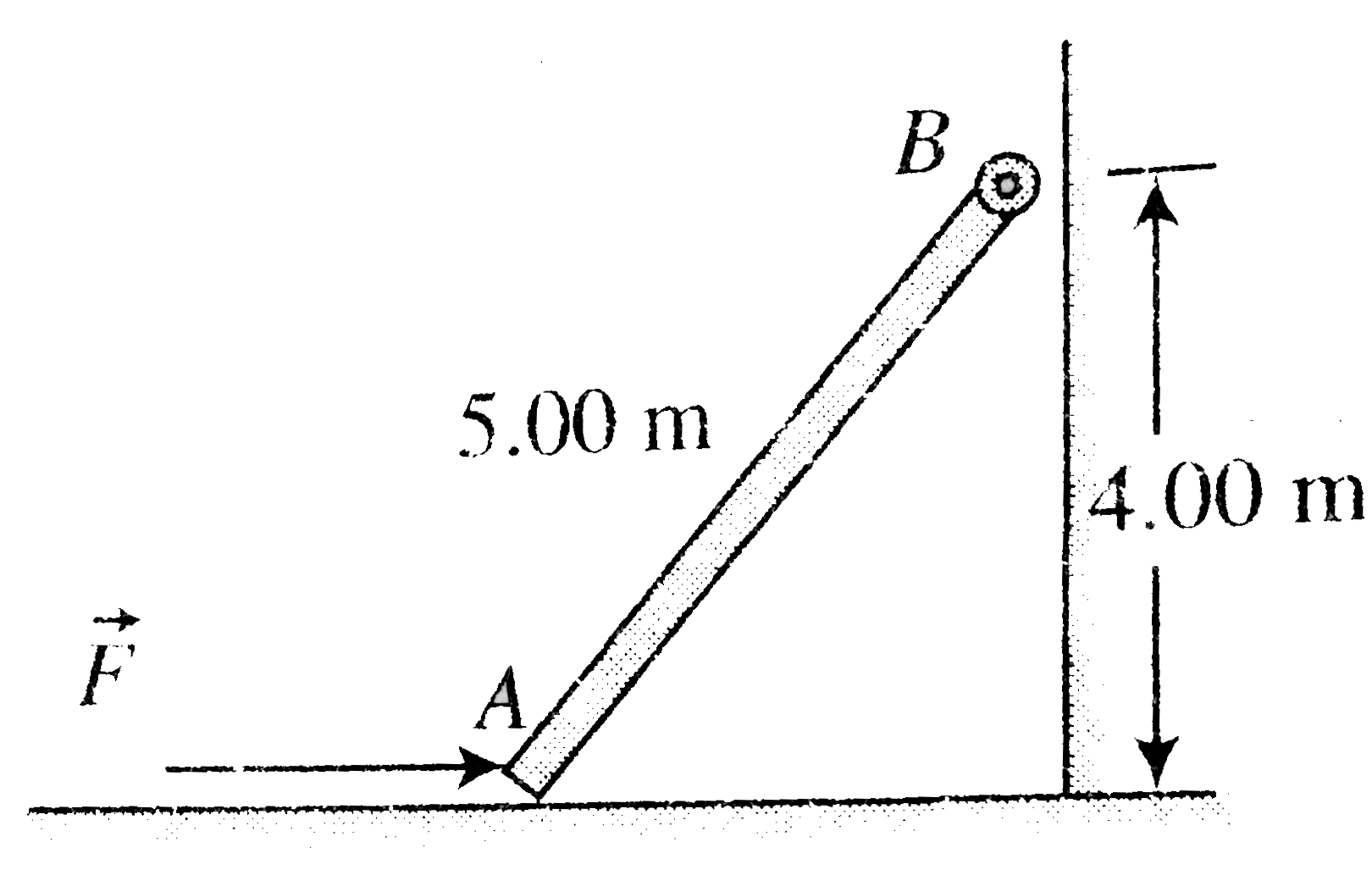End A of the bar AB in figure rests on a frictionless horizontal surface and end B is hinged. A horizontal force →F of magnitude 120N is exerted on end A. You can ignore the weight of the bar. What is the net force exerted by the bar on the hinge at B?

200N
140N
100N
none of these
The correct Answer is:A
The horizontal component of the force ederted on the bar by the hinge must balance the applied force →F, nnd os has magnitude 120.0N and is to the left. Taking torques bout point A,(120.0N)(4.00m)+Fv(3.0m) so the vertical componnet is −160N, with the minus sign indicting a downward compnent, exerting torque in a directin opposite that of the horizontal component. the force exerted by the bar on the hinge is equal in magnitude and opposite in direction of the force exertd by the hinge on the bar.
Net force √[(160)2+(140)2]=200N
Topper's Solved these Questions
- BOOK - CENGAGE PHYSICSCHAPTER - RIGID BODY DYNAMICS 1EXERCISE - Multiple Correct9videos
RIGID BODY DYNAMICS 1
- BOOK - CENGAGE PHYSICSCHAPTER - RIGID BODY DYNAMICS 1EXERCISE - Linked Comprehension28videos
RIGID BODY DYNAMICS 1
- BOOK - CENGAGE PHYSICSCHAPTER - RIGID BODY DYNAMICS 1EXERCISE - Subjective13videos
RIGID BODY DYNAMICS 1
- BOOK - CENGAGE PHYSICSCHAPTER - PROPERTIES OF SOLIDS AND FLUIDSEXERCISE - INTEGER_TYPE2videos
PROPERTIES OF SOLIDS AND FLUIDS
- BOOK - CENGAGE PHYSICSCHAPTER - RIGID BODY DYNAMICS 2EXERCISE - Interger2videos
RIGID BODY DYNAMICS 2
Similar Questions
You are on a frictionless horizontal plane. How can you get off if no horizontal force is exerted by pushing against the surface?
View SolutionA uniform bar of square cross-section is lying along a frictionless horizontal surface. A horizontal force is applied to pull it from one of its ends then
 View Solution
View Solution
Knowledge Check
- Question 1 - Select One
You are on a frictionless horizontal plane. How can you get off if no horizontal force is exerted by pushing against the surface
ABy jumpingBBy spitting or sneezingCBy rolling your body on the surfaceDBy running on the plane - Question 2 - Select One
A block of mass 3kg is at rest on a rough inclined plane as shown in the figure. The magnitude of net force exerted by the surface on the block will be
 A26NB19.5NC10ND30N
A26NB19.5NC10ND30N - Question 3 - Select One
A straight rope of length 'L' is kept on a frictionless horizontal surface and a force 'F' is applied to one end of the rope in the direction of its length and away from that end. The tension in the rope at a distance 'l' from that end is
AFlBLFlC(1−lL)FD(1+lL)F
A straight rod AB of mass M and length L is placed on a frictionless horizontal surface. A horizontal force having contstant magnitude F and fixed direction starts acting at the end A. The rod is initially perpendicular to the force. Find the initial acceleration of end B.
View SolutionA straight rope of length 'L' is kept on a frictionless horizontal surface and a force 'F' is applied to one end of the rope in the direction of its length and away from that end. The tension in the rope at a distance 'I from that end is 9
View SolutionA block of mass M is pulled along a horizontal frictionless surface by a rope of mass m. If a force P is applied at the free end of the rope , the force exerted by the rope on the block .
View SolutionA block of mass M is pulled along a horizontal frictionless surface by a rope of mass m. If a force P is applied at the free end of the rope, the force exerted by the rope on the block is
View SolutionA block of mass M is pulled along a horizontal frictionless surface by a rope of mass m. If a force P is applied at the free end of the rope, the force exerted by the rope on the block is
View Solution

